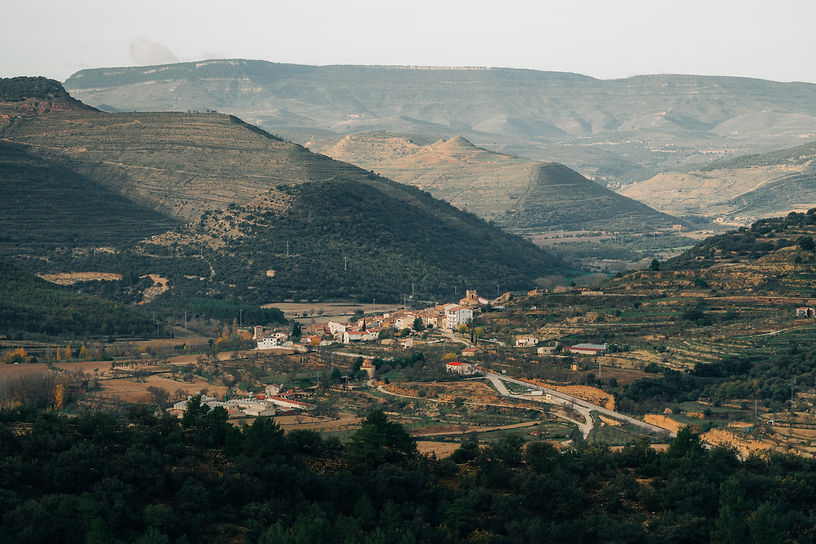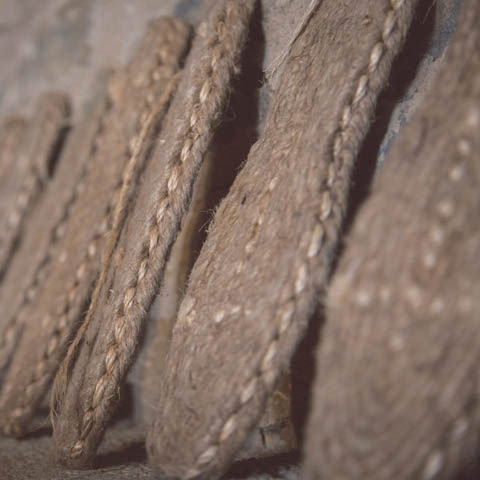
LA MATA
THE TOWN OF “THE ESPADRILLES”
La Mata is located in a gorgeous location, crossed by rivers Cantavieja and La Cuba and full of lush forests of oaks, holm oaks and bushes under the mountains of Tossal and Sant Pere. La Mata has a rich history, still appreciable in its medieval monuments, such as in manor houses as Casa Palau dels Pedro i La Figuera, la Casa Cremada, la Casa Palacio dels Vallés, the Town Hall, El Meson de la Vila, the church of Nostra Senyora de les Neus or la nevera, an ancient building designed to storage goods at low temperature. The traditional crafts have also been important throughout history, and today it still remains the handmade production of espadrilles or espardenyes. Outside the village, we can find several churches, such as Santa Bàrbara, Sant Gil -patron saint of the village- and Sant Cristòfol.
In its calendar, it highlights the unique celebration of l’Onso. This tradition represents the end of winter and the arrival of spring. Firts, the hunters start to seek L’Onso (a mythological animal represented by a person dressed in sackcloth and lamb skin and with the face and hands full of fat) in the forest and bring him tied to the town. There, L’Onso tries to stain locals and visitors and to escape. This tradition is a great festival and neighbours open their homes and offer food and drinks on the street.

MONUMENTS
LA MATA
Town Hall: This palace, which is considered Asset of Cultural Interest, is an example of Aragonese civil architecture from the 16th century. All the façade is protected under carved wooden eaves. Inside, they placed the prison, the baking furnace, which initially housed the wool market due to the large wool trade between Teruel and Castellón, and the Town Hall.
Manor houses: During the 17th and 18th centuries, La Mata hosted a large number of prominent personalities of the Valencian nobility, and proof of this are the various palatial buildings, such as Casa Palau dels Pedro i la Figuera, la Casa Cremada or el Palau dels Vallés

ESPARDENYES
LA MATA
The ethnological Museum of l’Espardenya, located in the ancient nevera from the 17th century -the building designed to storage food at low temperature thanks to snow- is currently a museum that unveils the traditional craft of the espadrille, or espardenya, the typical footwear of the area.

RELIGIOUS BUILDINGS
Nostra Senyora de les Neus church: The oldest part of the church was built back in the 16th century. In the 19th century, a more modern construction was carried out, which can be differentiated for its construction with mud brick. Its interior is of paramount interest for its paintings, elevated choir and the combination of tile and original hardwood floors in the main nave.
Santa Bàrbara hermitage: The shrine of Santa Bàrbara is 3 km from the village and dates from the 17th century. The temple measures 25 meters deep and 10 meters wide. In other times, a pilgrimage was done and it housed a weekly market and for people living in masos or farmhouses.
Sant Gil hermitage: shrine consecrated to the patron saint of the town which was built in 1786. It features a small chapel with a porch and three pointed arches. La Mata celebrates its patron saint on Septembers 1st and during the festivities of August.
NATURAL RESOURCES
Les Calderotes: Natural pools formed by the river.
El Toll Negre: Natural dam which is named because of the impossibility of having light in this giant pond.




FESTIVITIES AND TRADITIONS
Sant Antoni
Main celebration of winter, which has fire as protagonist.
Date: January
El Onso
It is a peculiar representation of the end of winter and the arrival of spring. Hunters start to seek L’Onso (a mythological animal represented by a person dressed in sackcloth and lamb skin and with the face and hands full of fat) in the forest and finally bring him tied to the town. For further information
Date: On Saturday, when spring arrives.
Patronal festivities in honour of Sant Gil Abad:
Most participative festivities of the year, with bull-fighting, parties and a number of popular and festive events.
Date: first week of August













